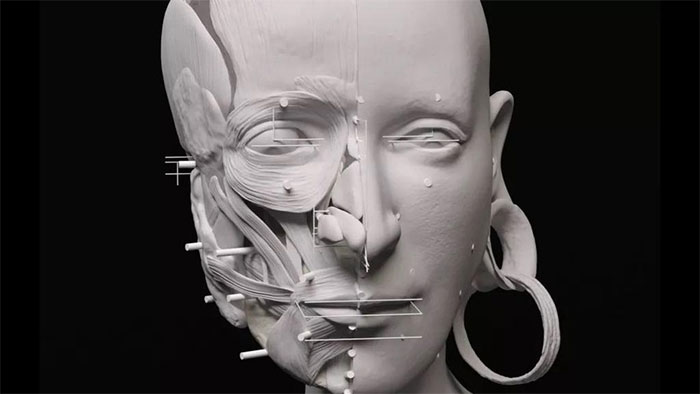The mystery of the powerful woman with giant earrings
A powerful woman buried with a silver coin in Bronze Age Spain has been digitally reconstructed to show a slender face and giant dangling earrings.
Earlier this year, researchers announced they had discovered the remains of a woman and a man buried together in a large ceramic urn in what is likely an ancient palace. The man died several years before the woman and after the woman died her body was placed next to the man's body.
Now, using part of the skull and jewelry from the burial site, a graphic artist has digitally reconstructed the woman's face, as well as the faces of others buried. at that site, called La Almoloya.

The face of a powerful woman from the Bronze Age was digitally recreated.
"The biggest challenge with this facial reconstruction is that the upper part of a woman's skull hasn't survived through the ages," said Joana Bruno, a freelance science illustrator who created the reconstructions. digital creator and is a collaborator with archaeologists La Almoloya at the Autonomous University of Barcelona, Spain.
Bruno added: "Thankfully, the silver tiara was found in the right place, around this woman's head, so we were able to measure her head, but that's still the case. is a challenge."
The identity of the headband-wearing woman has caught the attention of scientists since archaeologists unearthed her burial place in 2014. Her lavish burial accessories - including a beaded necklace , ring, bracelet, silver bracelet and spiral earplugs, as well as a silver frame.
The researchers had previously said that a drinking vessel and a silver-handled awl, a tool used for tearing textiles, were of superior quality and more valuable than the goods buried with the man.
Perhaps these precious objects show that a woman has more power than her partner, the researchers say, especially when this woman outlives her partner, and still has buried with valuables.
Before facial reconstruction, anthropologists clean, stabilize, and study the deceased's skeleton to determine the person's sex, age of death, general health, and other characteristics.
This information is always taken into account during facial reconstruction, says Bruno. In the case of a Bronze Age woman who died between the ages of 25 and 30 and suffered from several congenital diseases, including missing cervical vertebrae and ribs.'
Next, Bruno took specific measurements of the skull and performed laser scans of the skull and mandible. The laser scanning process allows Bruno to work with a digital copy of the original and minimizes manipulation of bones, which are fragile. Then, to "make up" the face, Bruno relied on published techniques to estimate the position of facial features, such as eyes, nose and mouth, and determine the thickness of the facial features. tissue.
Bruno's entire process and collaborations with anthropologists emphasize his ability to estimate and reconstruct missing skeleton parts with the greatest accuracy possible and without damaging the original, Cristina Rihuete Herrada, professor of archeology at the Autonomous University of Barcelona and colleagues.
Thanks to the 3D laser scanning of the jewelry, the Bronze Age woman's face appeared beautifully shimmering.
- Video: Smart earrings monitor physical fitness
- Why do pirates and sailors wear this item?
- The eternal beauty of earrings of 2,500 years old
- Found 2,000 year old earrings
- Scientists are developing earrings, rings and contraceptive watches
- The mystery of a woman's hair is still black even though she died 3,000 years
- Entire items of Vietnamese women 3,000 years ago
- The mystical mystery 'hunter woman' 3,900 years old
- Cleopatra - the most powerful woman of the ancient world
- The mystery in the body of pregnant women
- The lecherous, cruel American woman becomes the most powerful queen
- The scary mystery about a bloody woman who is also afraid
 Discovered an ancient centipede fossil 99 million years old
Discovered an ancient centipede fossil 99 million years old Discovered bat-like dinosaurs in China
Discovered bat-like dinosaurs in China Discovered a 200-year-old bronze cannon of the coast
Discovered a 200-year-old bronze cannon of the coast Discover 305 million-year-old spider fossils
Discover 305 million-year-old spider fossils Revealing the mystery of the woman who lived alone for nearly two decades on a deserted island
Revealing the mystery of the woman who lived alone for nearly two decades on a deserted island  When the world's tallest and shortest women meet
When the world's tallest and shortest women meet  Photos change the view of history
Photos change the view of history  'Rebirth of the vampire': The mystery of the brick-mouthed remains of the 16th century
'Rebirth of the vampire': The mystery of the brick-mouthed remains of the 16th century  World's oldest fake eye discovered
World's oldest fake eye discovered  The female explorers 'shocked' the history of world tourism
The female explorers 'shocked' the history of world tourism 